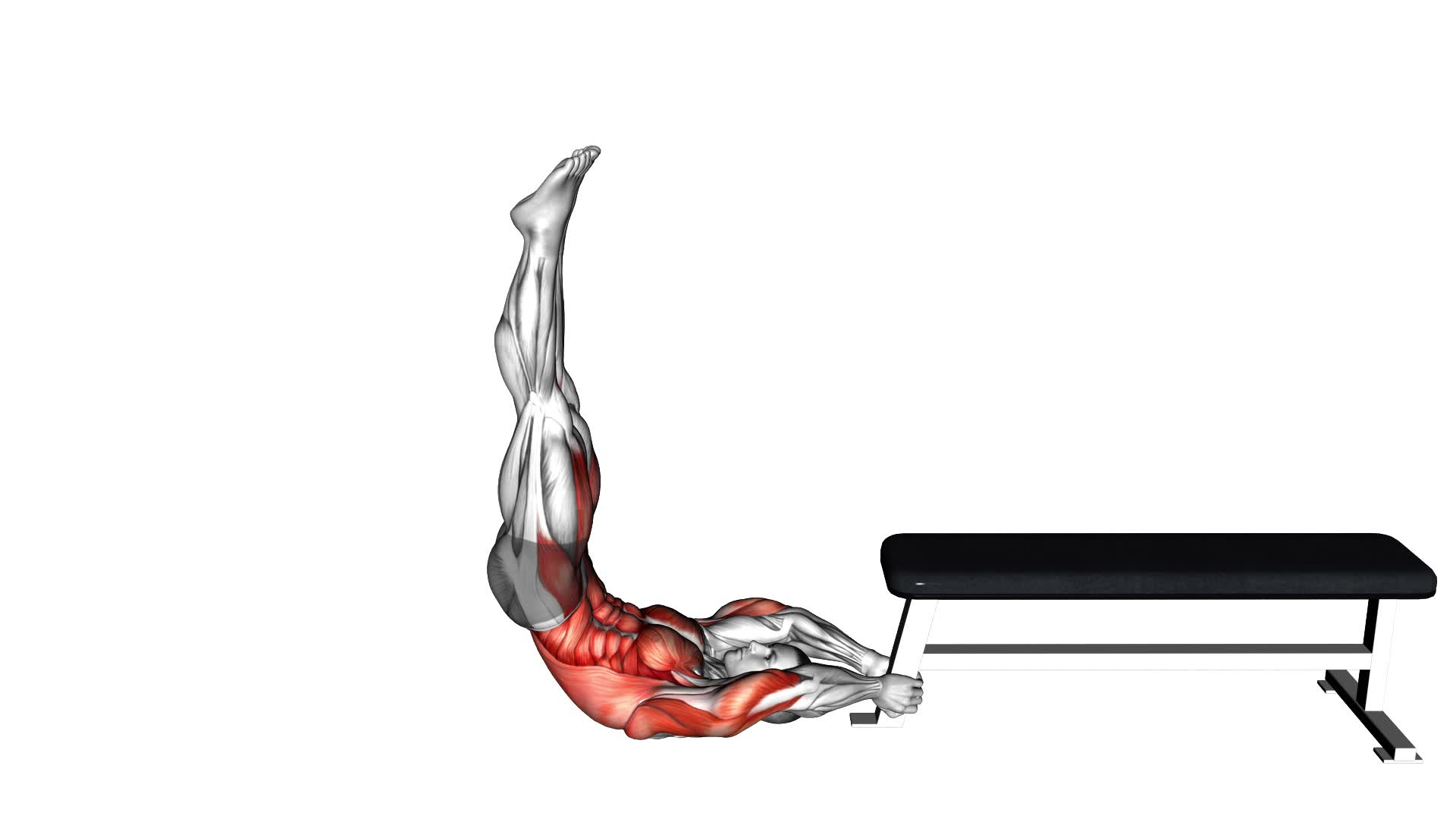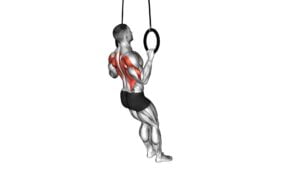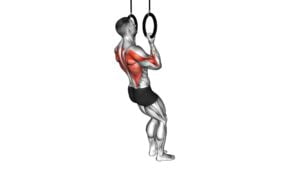Self Assisted Inverted Pullover – Video Exercise Guide & Tips

Looking to strengthen your upper body?
Watch This Exercise Video
Check out the self-assisted inverted pullover! This exercise targets your back, shoulders, and arms, helping you build strength and improve posture.
In this video exercise guide, we'll show you the proper technique, common mistakes to avoid, and tips to increase the difficulty.
Whether you're a beginner or advanced, this exercise can be modified to suit your fitness level.
Get ready to take your workout to the next level!
Key Takeaways
- Targets multiple muscle groups in the upper body
- Strengthens and tones the back muscles, including the latissimus dorsi
- Improves shoulder stability and mobility
- Engages core muscles for stability and balance
Benefits of the Self-Assisted Inverted Pullover
What are the benefits of performing the self-assisted inverted pullover?
The self-assisted inverted pullover is a highly effective exercise that targets multiple muscle groups in your upper body. By incorporating variations of this exercise into your workout routine, you can experience a range of benefits.
One of the main benefits of the self-assisted inverted pullover is its ability to strengthen and tone your back muscles. This exercise primarily targets your latissimus dorsi, which are the large muscles in your back responsible for pulling movements. Additionally, it engages your rhomboids, trapezius, and biceps, helping you develop a strong and well-defined upper body.
Another advantage of the self-assisted inverted pullover is its ability to improve your shoulder stability and mobility. As you perform the exercise, you're required to stabilize your shoulder joints, which can enhance their overall strength and function. This can be particularly beneficial for athletes who rely on their upper body strength for performance in sports such as swimming or rock climbing.
In addition to these benefits, the self-assisted inverted pullover also engages your core muscles, promoting stability and balance. By incorporating this exercise into your routine, you can develop a strong and functional core, which is essential for maintaining proper posture and preventing injuries.
Now that you understand the benefits of the self-assisted inverted pullover, let's move on to discussing the equipment and setup for this exercise.
Equipment and Setup for the Exercise
To properly execute the self-assisted inverted pullover, you'll need a sturdy pull-up bar and a resistance band. Here are some key equipment options, variations, and progressions to consider for this exercise:
- Pull-Up Bar: Choose a pull-up bar that's securely mounted and can support your body weight. Make sure it's at a height that allows you to hang freely with your arms fully extended.
- Resistance Band: Select a resistance band that provides enough tension to assist you in completing the movement. The band should be securely attached to the pull-up bar and positioned so that you can easily reach it with your feet.
- Progressions: As you become more proficient in the self-assisted inverted pullover, you can increase the difficulty by using a thinner resistance band or removing the band altogether. Another progression is to slow down the movement and focus on control and stability throughout the exercise.
Proper Technique for the Inverted Pullover
To perform the inverted pullover with proper technique, there are a few common mistakes you should avoid. These include:
- Using momentum to swing your body
- Arching your back excessively
- Not engaging your core muscles
Common Mistakes to Avoid
To ensure proper technique for the Inverted Pullover, it's crucial to focus on avoiding common mistakes. Here are three common mistakes to watch out for when performing this exercise:
- Arching your back: One of the most common mistakes is arching your back excessively during the movement. This puts unnecessary strain on your lower back and can lead to injury. Make sure to engage your core and maintain a neutral spine throughout the exercise.
- Using momentum: Another mistake is using momentum to swing your body up and down. This takes away the focus from the targeted muscles and reduces the effectiveness of the exercise. Instead, focus on controlled movements and use your upper body strength to lift yourself up.
- Neglecting proper form: It's important to maintain proper form throughout the exercise. This includes keeping your shoulders down and back, engaging your lats, and fully extending your arms at the bottom of the movement.
Benefits of Proper Technique
By using proper technique for the Inverted Pullover, you can maximize the benefits and minimize the risk of injury. The benefits of using proper technique include improved muscle strength and flexibility, increased upper body stability, and enhanced shoulder mobility.
When performing the Inverted Pullover with correct form, you engage the muscles in your back, shoulders, and arms more effectively, leading to better overall muscle development. Additionally, proper technique helps to maintain proper alignment and reduce stress on the joints, reducing the risk of injury.
It's important to focus on form throughout the exercise, keeping your core engaged, maintaining a neutral spine, and controlling the movement with your muscles rather than relying on momentum. Remember, practicing proper technique is essential for maximizing the benefits of the Inverted Pullover and ensuring your safety during the exercise.
Common Mistakes to Avoid
To perform the Self Assisted Inverted Pullover correctly and effectively, it's crucial to maintain proper form throughout the exercise. Avoid the temptation to rely on excessive momentum, as this can compromise the target muscles and increase the risk of injury.
Additionally, pay attention to your breathing techniques, ensuring that you breathe steadily and engage your core for stability and control.
Proper Form Importance
Maintain proper form to maximize the effectiveness of the self-assisted inverted pullover and avoid common mistakes.
Proper form is crucial for any exercise, and the self-assisted inverted pullover is no exception. By maintaining the right form, you can ensure that you're targeting the right muscles and minimizing the risk of injury.
Here are some important reasons why proper form is important for the self-assisted inverted pullover:
- Importance of alignment: Proper form helps you maintain the correct alignment of your body, ensuring that you're engaging the right muscles and avoiding unnecessary strain on other parts of your body.
- Maximizing muscle activation: By using proper form, you can target the intended muscles more effectively, allowing you to reap the full benefits of the exercise.
- Reducing the risk of injury: Proper form helps you perform the self-assisted inverted pullover safely, reducing the risk of strains, sprains, or other injuries that may occur due to poor alignment or technique.
Remember to always prioritize proper form to get the most out of your self-assisted inverted pullover and prevent any unnecessary injuries.
Avoiding Excessive Momentum
Focus on controlled movements to avoid excessive momentum during the self-assisted inverted pullover. By doing so, you'll be able to increase stability and maximize muscle engagement.
Excessive momentum can compromise the effectiveness of the exercise and potentially lead to injury. To avoid this, make sure to maintain a slow and controlled pace throughout the movement. Focus on using your core and upper body strength to lift your body up, rather than relying on swinging or jerking motions.
By doing this, you'll engage the targeted muscles more effectively and reduce the risk of momentum taking over.
Now, let's move on to the next section and discuss breathing techniques for stability.
Breathing Techniques for Stability
As you perform the self-assisted inverted pullover, it's crucial to master proper breathing techniques to maintain stability and avoid common mistakes. Here are three breathing techniques that can help you enhance your core stability during this exercise:
- Diaphragmatic Breathing: Take deep breaths, expanding your belly as you inhale and contracting it as you exhale. This type of breathing engages your diaphragm and helps stabilize your core.
- Exhale on the Effort: Exhale forcefully as you pull yourself up, using your lats and core muscles. This technique helps activate your muscles and maintain stability throughout the movement.
- Avoid Holding Your Breath: Many people tend to hold their breath during challenging exercises. Remember to breathe continuously throughout the movement to ensure a steady flow of oxygen to your muscles and maintain stability.
By practicing these breathing techniques, you can improve your core stability and maximize the benefits of the self-assisted inverted pullover.
Now, let's move on to the next section to learn some tips to increase the difficulty of the exercise.
Tips to Increase the Difficulty of the Exercise
To make the exercise more challenging, you can try incorporating a stability ball into your self-assisted inverted pullover routine. Using a stability ball can help increase the intensity and modify the difficulty of the exercise, providing an extra challenge for your muscles.
To incorporate a stability ball, start by sitting on the ball with your feet firmly planted on the ground. Slowly walk your feet forward, rolling the stability ball away from you until your upper back is resting on the ball. Your knees should be bent at a 90-degree angle, and your hips should be raised off the ground.
Once you're in this position, you can perform the self-assisted inverted pullover as usual. However, the instability of the stability ball will require your core muscles to work harder to maintain balance and control throughout the exercise. This added challenge will further engage your core, shoulders, and upper body muscles, increasing the overall intensity of the exercise.
Remember to focus on maintaining proper form and control throughout the movement. Start with a lighter stability ball and gradually increase the difficulty as you become more comfortable and confident with the exercise. Always listen to your body and modify or adjust the exercise as needed to prevent any discomfort or injury.
Safety Precautions and Modifications for Beginners
If you're new to the self-assisted inverted pullover exercise, it's important to take certain safety precautions and make modifications to ensure a safe and effective workout. Here are some safety modifications and beginner tips to keep in mind:
- Start with a spotter: Since this exercise involves hanging upside down, it's always a good idea to have someone nearby to assist you. They can help you get into position and provide support if needed.
- Use a sturdy bar or equipment: Make sure the bar or equipment you're using is secure and can hold your weight. It's important to have a stable surface to perform the exercise on to prevent any accidents or injuries.
- Gradually increase intensity: As a beginner, it's crucial to start with a lower intensity level and gradually increase it over time. Listen to your body and only push yourself as far as you can comfortably go. If you feel any pain or discomfort, stop immediately.
Frequently Asked Questions
How Many Repetitions Should I Do for the Self-Assisted Inverted Pullover?
For the self-assisted inverted pullover, the number of repetitions depends on your fitness level and goals. Start with a comfortable amount, like 8-10 reps, and gradually increase as you get stronger.
Beginners can modify this exercise by using a resistance band or assistance from a partner. To make it more challenging, try using a heavier band or reducing assistance.
Remember to listen to your body and adjust the reps accordingly.
Can I Do the Self-Assisted Inverted Pullover if I Have a Shoulder Injury?
If you have a shoulder injury, it's important to be cautious with exercises like the self-assisted inverted pullover. This exercise puts a lot of strain on the shoulders and may exacerbate your injury.
It's best to consult with a healthcare professional or a qualified trainer for modifications or alternative exercises that are safe for your shoulder injury. Prioritizing your safety and allowing your shoulder to heal is crucial for a successful recovery.
Can I Use a Resistance Band Instead of a Towel for the Self-Assisted Inverted Pullover?
Yes, you can use a resistance band instead of a towel for the self-assisted inverted pullover.
Using a resistance band provides an alternative way to perform this exercise and can offer its own unique benefits.
However, it's important to note that using a towel can help improve grip strength and stability during the exercise.
Is It Normal to Feel Discomfort in My Back During the Self-Assisted Inverted Pullover?
Feeling discomfort in your back during the self-assisted inverted pullover isn't unusual. It might be due to improper form or lack of strength in your back muscles.
Make sure to maintain a neutral spine and engage your core throughout the exercise.
If the pain persists, it's best to consult with a professional to ensure proper technique and prevent any potential injuries.
Can I Perform the Self-Assisted Inverted Pullover on Any Type of Pull-Up Bar?
Yes, you can perform the self-assisted inverted pullover on any type of pull-up bar. It's a versatile exercise that can be modified to suit different equipment. Performing modifications allows you to adjust the difficulty level and target specific muscle groups.
The self-assisted inverted pullover offers numerous benefits, such as strengthening your back, shoulders, and core. Incorporating this exercise into your routine can help improve your overall upper body strength and stability.
Conclusion
In conclusion, the self-assisted inverted pullover is a beneficial exercise that targets the upper body and core muscles. By using proper technique and avoiding common mistakes, individuals can safely increase the difficulty of the exercise and achieve their fitness goals.
Beginners should take necessary precautions and make modifications as needed to ensure a safe and effective workout. Incorporating this exercise into a regular fitness routine can lead to improved strength and overall fitness.

Author
Years ago, the spark of my life’s passion ignited in my mind the moment I stepped into the local gym for the first time. The inaugural bead of perspiration, the initial endeavor, the very first surge of endorphins, and a sense of pride that washed over me post-workout marked the beginning of my deep-seated interest in strength sports, fitness, and sports nutrition. This very curiosity blossomed rapidly into a profound fascination, propelling me to earn a Master’s degree in Physical Education from the Academy of Physical Education in Krakow, followed by a Sports Manager diploma from the Jagiellonian University. My journey of growth led me to gain more specialized qualifications, such as being a certified personal trainer with a focus on sports dietetics, a lifeguard, and an instructor for wellness and corrective gymnastics. Theoretical knowledge paired seamlessly with practical experience, reinforcing my belief that the transformation of individuals under my guidance was also a reflection of my personal growth. This belief holds true even today. Each day, I strive to push the boundaries and explore new realms. These realms gently elevate me to greater heights. The unique combination of passion for my field and the continuous quest for growth fuels my drive to break new ground.







